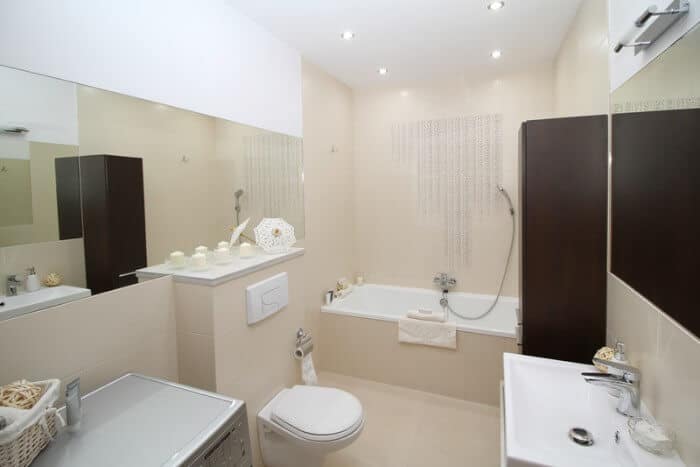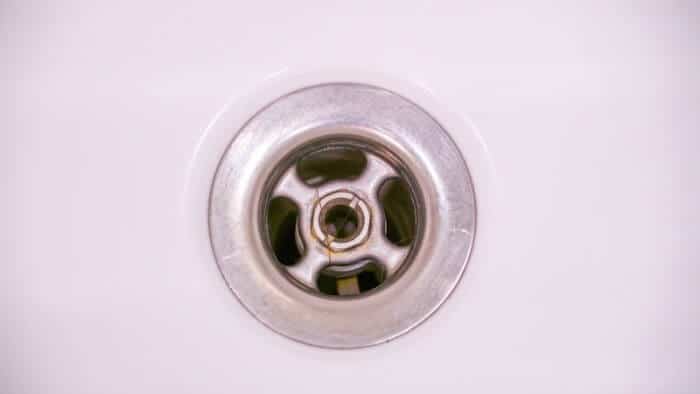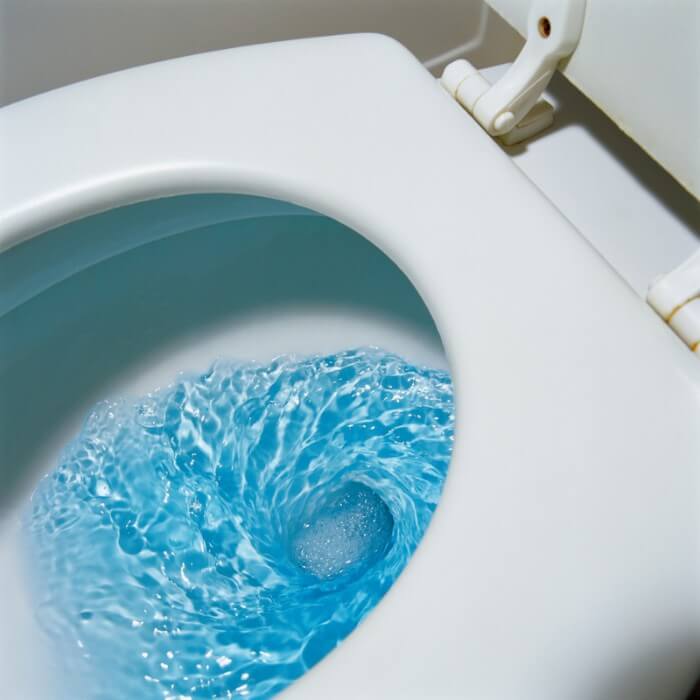It’s embarrassing if your bathtub drain gurgles when the toilet is flushed, especially if you’re having some friends over for dinner.
Luckily, you might be able to solve this problem without having to call a plumber. Most commonly, gurgling is caused by a clogged vent stack. Cleaning the vent screen or using a sewer auger often solves the issue.
If your vents are clear, then take a look at your toilet drain. A couple of plunging rounds might remove any soft clogs.
If these didn’t work, keep reading. We’ll take a systematic look at the issue to see how you can solve it.
First Things First, Do You Know How Your Plumbing System Works?
Before carrying on with the problems and solutions, I need to make sure you have basic plumbing knowledge.
I won’t dive too deep, I promise. Just a quick crash course so you won’t get lost between all the vents, pipes, and fixtures you have in your home. If you already know your way around your plumbing, feel free to skip this section.
Typically, a residential plumbing system is composed of four parts: waste drains, waste vents, portable water, and rainwater management system. For this DIY guide, we’re only interested in the first two.
Waste Drains Carry Down Wastewater
All your home fixtures, like the bathtub and toilet, are connected to a large drain pipe via small pipes of varying sizes.
Wastewater flows down the drains only by gravity, that’s why they’re installed with a slight slope. The water keeps flowing until it reaches the municipal drainage system or the septic tank, whatever your home is connected to.
Waste Vents Regulate Air Pressure
When you flush your toilet, the water pushes the front air downstream with it. Now, if there’s no water or air inside the pipes, they would be crushed by the external atmospheric pressure.
So, to prevent this from happening, your waste drains are connected to a large vent stack that sticks out from the roof. This way, when water flows down the drain, air will flow from the vent to equalize the pressure.
The waste vents also function in releasing the sewage gases that normally builds up inside the main pipe.
The Magical P-Trap Keeps Your Home Smelling Good
So, we established that sewage gases are supposed to escape through the vents into the roof where nobody can smell them.
But what stops them from going back in your toilet and drains instead? Look down your sink to find the answer. It’s all thanks to the U-shaped part that’s called a P-trap.
The P-trap holds water in its lower dip, which prevents gases from flowing into your house.
Although a toilet doesn’t have an actual P-trap, its built-in features function in the same way. That’s why your toilet bowl holds the water, if you’re wondering.
So, now that we’ve covered the basics, you’re ready to carry on with the actual troubleshooting.
Also Read:
1. Chek Your Vents Arent Clogged
As I stated in the previous section, when you flush your toilet, air must replace the flowing water to maintain pressure inside the pipes. Where does this air come from? The roof vent.
But what happens if the air vent got clogged and no air would flow through it anymore? We have two possibilities.

Firstly, no air flows and vacuum forms inside the pipes. Luckily, this needs extreme physical conditions to happen, or else your pipes would instantly crush by external air pressure.
So, that leaves us with the second possibility, air will be sucked inside the pipe through the nearest fixture, which is the bathtub in your case.
It’s Like Pouring Water From a Bottle
Still having a hard time grasping this concept? Well, I’ve got a little experiment that you can do.
Grab a full water bottle and hold it upside down over your sink. From that position, open the cap completely. The water should start pouring while gurgling.
Now try it again after poking a small hole in the bottle’s base. You should notice that there’s no gurgling anymore.
The gurgling happened because the air was trying to enter from the same place where water was pouring. But when you provided a “vent” in the bottle, the air started flowing from the top while water poured towards the bottom.
So, How Can You Fix It?
Just like what you did to the bottle, you need to clear your venting system by removing the clogs, and that’s when it gets a little tricky.
Why? Because the vent stack runs through the whole length of your house. The clog could be anywhere along the way.
But don’t call your plumber just yet because you might be able to reach it yourself.
Clean Your Vent Screen
Is your vent stack covered by a screen? If so, you’ll most likely find the screen holes completely obstructed by dirt. In this case, cleaning the screen would, hopefully, resolve the problem.
If you don’t have a screen installed, you should have. Otherwise, the vent stack would be left open for dirt, leaves, or even small critters to go inside and clog it.
If you couldn’t find a screen to match your stack size, you can easily craft one yourself from hardware cloth.
Use a Garden Hose to Pour Water Down the Vent
If cleaning the screen didn’t work, that means the clog is located deeper. Start by spraying some water down the stack with your garden hose.
In most cases, the clog is just a soft buildup of moisture and dirt. So the water pressure should be able to flush it down.
However, try not to flood the pipe with too much water at first. If the clog is hard, the water will back up and ruin your roof.
Or Use a Sewer Auger
If you’re unlucky enough to have a hard clog down your vent, you’ll need to mechanically push it along with the water.
But what can go through that restricted, deep area? Luckily, you won’t have to use your hand! Instead, use a sewer auger, aka a plumbing snake.
If you’ve never seen it before, this is a drum-shaped tool that houses a long, flexible stainless steel wire. As you rotate the knob, the wire rotates within the pipe to extract any clog, however hard or deep it is.
If water still backs up no matter how much you rotate, that means the clog is way out of your reach.
Calling a plumber is imperative at this point. Tell him about your progress so that he can be prepared. Some plumbers have sewer augers with a built-in camera to be able to see where exactly does the clog stand.
According to pipe & plumbing professional Shane Bruce, modern companies often can usually offer you a video consultation to clarify what the problem is.
2. Maybe Your Drain Pipes Are Too Narrow
In the previous point, we reasoned that air is flowing through your bathtub to compensate for the clogged vent. However, sometimes the vent is clear, but the skink still gurgles.
In this case, the air isn’t entering the pipes, it’s actually coming out.
After you flush your toilet, the water pushes the air downstream. If the pressure builds up too much, air will find it easier to back up through the nearest fixture.

There are a bunch of reasons that can cause this gurgle. Firstly, your toilet may be flushing more water than your pipes can handle. Putting a brick in your toilet tank is the easiest way to solve this issue, alternatively quiet flush toilets generally use much less water.
However, if the problem appeared recently, then the waste pipes are to blame.
Some of the toilet waste inevitably gets stuck over the pipe walls. With time, this waste starts to decompose and harden. It won’t directly clog your pipes, but it’ll make them incredibly narrower.
So, when the slightest amount of water flows in, pressure builds and air gurgles in your bathtub.
A Forceful Plunging Could Do the Trick
If you’re lucky, a plunger might be able to push some of the hardened waste to widen the pipes.
Before you start, close the drains of your bathtub, sinks, or any other fixtures with rubber plugs. This way, all of your plunging forces would remain inside the pipes.
Or Use a Toilet Auger for Stubborn Clogs
If the gurgling persists after 3-4 rounds of plunging, rest your poor arms and shoulders because this won’t work.
You’ll need to use a toilet auger. It shares the same principle of the regular drain auger, but it’s equipped with a long arm to drive the wire deeper.
Use the auger cautiously to avoid scratching your toilet bowl.
The auger plastic shaft is curved toward the end for this purpose. Therefore, you shouldn’t push or pull the auger wire unless it’s fully tucked into the plastic.
3. Check Your Bathtub P-Trap
If none of the previous solutions worked, I’m sad to tell you that this is where you can’t DIY anymore.
If your bathtub is old, its P-trap might’ve become rusty that it started to leak. If this is the case, the gurgling should be the first nuisance. You might find water leaking from the roof or walls beneath your bathtub.
How to make sure it’s the P-trap? Simply, sniff your bathtub drain. It won’t smell like lavender, that’s for sure. But it shouldn’t smell awful. If so, that means the P-trap can’t hold the water in its dip, which allows the sewer smell to back up from the drain.

If you made sure this is the culprit, you should instantly call a plumber. He should find his way around your bathtub to replace the faulty P-trap in no time.
4. Replace Old Cast Iron Pipes
Cast iron was widely used in plumbing systems before the emergence of ABS and PVC pipes.
Unlike its successors, cast iron has a high tendency of corrosion. The rough surface of corroded pipes causes more waste and minerals to precipitate.
As we established before, narrow pipes build up air pressure as water flows. This makes the air escape through the drain, producing those annoying gurgles.
Needless to say, replacing those pipes requires a lot of technical skills. Therefore, it’s better to hire a professional plumber.
To Sum Up
There are a lot of problems that can make your bathtub drain gurgle when the toilet is flushed. Most commonly, you’ll find a clog hanging in your venting system. This creates a negative pressure and sucks air from one of your fixtures.
If the vents are clean, check your toilet’s drain pipe. Waste could slowly narrow your pipes and increase the air pressure inside. Plunging can remove soft debris but you might want a toilet auger for harder clogs.
Lastly, don’t ignore the gurgling noises however faint they are. It’ll be a lot easier to deal with clogs if they formed recently.
As an Amazon Associate I may earn a small fee from qualifying purchases at no extra cost to you. This helps us run the site, so thanks for your support!
